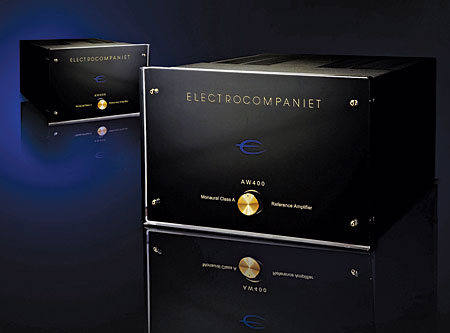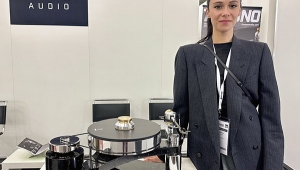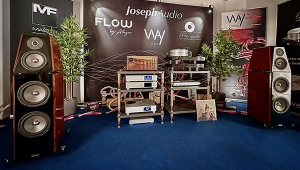| Columns Retired Columns & Blogs |
Electrocompaniet AW400 monoblock power amplifier
One of my favorite parental duties is dispensing advice that's calculated to make me sound wiser than I am. Among those pearls: Every so often you should change your point of view—your philosophies—just to see if your opinions can stand the strain. In doing so, you may discover a few things that are better than you expected them to be!
Footnote 1: I've often decried the silliness of fitting domestic amplifiers with rack-mount faceplates, but in this case there was a good reason: That name wouldn't have fit on a narrower panel!—Art Dudley

I admit that, when I made up that nonsense, I had certain vegetables in mind. But late one night, when an unpleasant bout of thinking kept me awake, I realized that there are a great many older people, such as myself, whose belief systems could also stand a bit of shaking up. Surely, if there's more to heaven and earth than is dreamed of in our philosophies, it's far easier to change the latter than the former.
And then it happened: Mere days later, I was offered the chance to write about a powerful solid-state amplifier, the likes of which I hadn't experienced in ages. How could I say no?
Electrocompaniet
Among the historically well-regarded makers of solid-state amplifiers—Mark Levinson, Krell, and Threshold come to mind—one of the most notable of all is from a nation with fewer inhabitants than the city of Baghdad: the Norwegian firm Electrocompaniet, whose 1973 premiere gained it recognition in virtually every hi-fi market around the globe.
That debut product, snappily named The 2-Channel Audio Power Amplifier (footnote 1) also heralded the arrival of Matti Otala, a Finnish college professor and electronics engineer whose work is also associated with Philips, Harman/Kardon, Nokia, and Robert Bosch GmbH. In 1973, Dr. Otala presented to the Audio Engineering Society a paper in which he described a distortion mechanism called transient intermodulation, or TIM, and which had otherwise gone undetected, apparently because the standard measurements of the day relied overmuch on steady-state test tones (footnote 2). Dr. Otala proved that the nonlinearities he described were audibly present in solid-state amplifiers that used global feedback to reduce other, more commonly known distortions.
For the technically minded, Otala's work influenced the way we look at feedback loops and amplifier slew rate; for those more interested in audio philosophies—there's that word again—Otala and, by extension, Electrocompaniet underscored the danger in suggesting that any existing suite of measurements can say all that needs to be said about an amplifier's musical performance, and reminded us that measuring without listening is of limited value. (So, too, is the opposite—for the designer, at least.)
Matti Otala never actually worked for Electrocompaniet; today he's a professor of Technology Management at the University of Technology in Tampere, Finland. But the Norwegian engineer Terje Sandstrom, who was instrumental in turning Otala's theories into a practical commercial amplifier, continues as mentor to Electrocompaniet's design team—whose recent fruits include the AW400 monophonic amplifiers ($12,500/pair). The AW in the model designation is a subtle reference to Electrocompaniet's Ampliwire models of bygone years, while the 400 signifies that this solid-state amp is capable of passing 400W, without clipping, across an 8-ohm load (not to mention 765W across 4 ohms and 1010W across 2 ohms).
The Electrocompaniet AW400 has the added distinction of being fully balanced: From its tidy input boards through the appropriately rugged banks of heatsunk output devices, each AW400 is as symmetrical an amp as I've seen—although I could see less of their innards than I'm used to, given the manner in which the circuit boards and RF shields are arranged. (A telltale bolt betrayed a toroidal mains transformer, but other parts of the puzzle remained unseen.) I was very impressed with the AW400's mechanical construction: The sheet-metal chassis, in tandem with a pair of metal straps between the two banks of heatsinks—not unlike the crossbars one sees in the engine compartments of certain high-performance cars—provide the requisite rigidity, without the kind of crazy-high mass that adds far more to the cost than to the performance (in my opinion). And the front panels are nicely finished sheets of clear acrylic, backlit in blue—beautiful, but not, in the manner of other high-end amps, pointlessly so.
Setup and installation
Anxious though I was to try something from outside my usual philosophy, there was a catch: The Electrocompaniet AW400 is optimized for true balanced operation, and my reference system is not. In particular, the output of my Shindo Masseto preamplifier, though sensibly low in impedance, is decidedly single-ended.
Footnote 1: I've often decried the silliness of fitting domestic amplifiers with rack-mount faceplates, but in this case there was a good reason: That name wouldn't have fit on a narrower panel!—Art Dudley
Footnote 2: "An Audio Power Amplifier for Ultimate Quality Requirements," by Jan Lohstroh and Matti Otala, presented at the 44th AES Convention (March 1973), Paper H-6, available from www.aes.org.—Ed.
- Log in or register to post comments




































